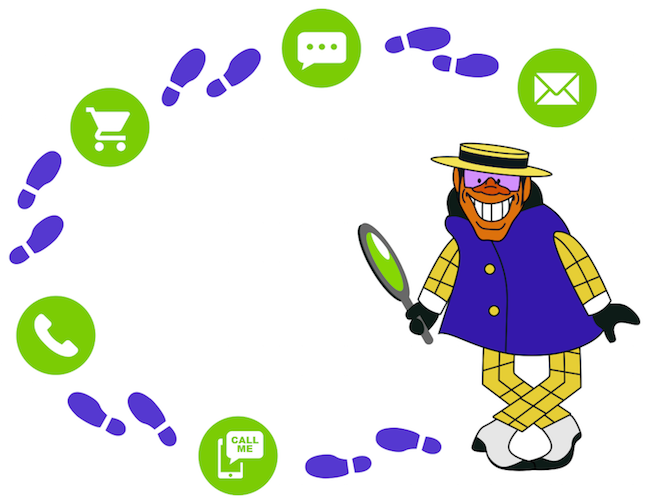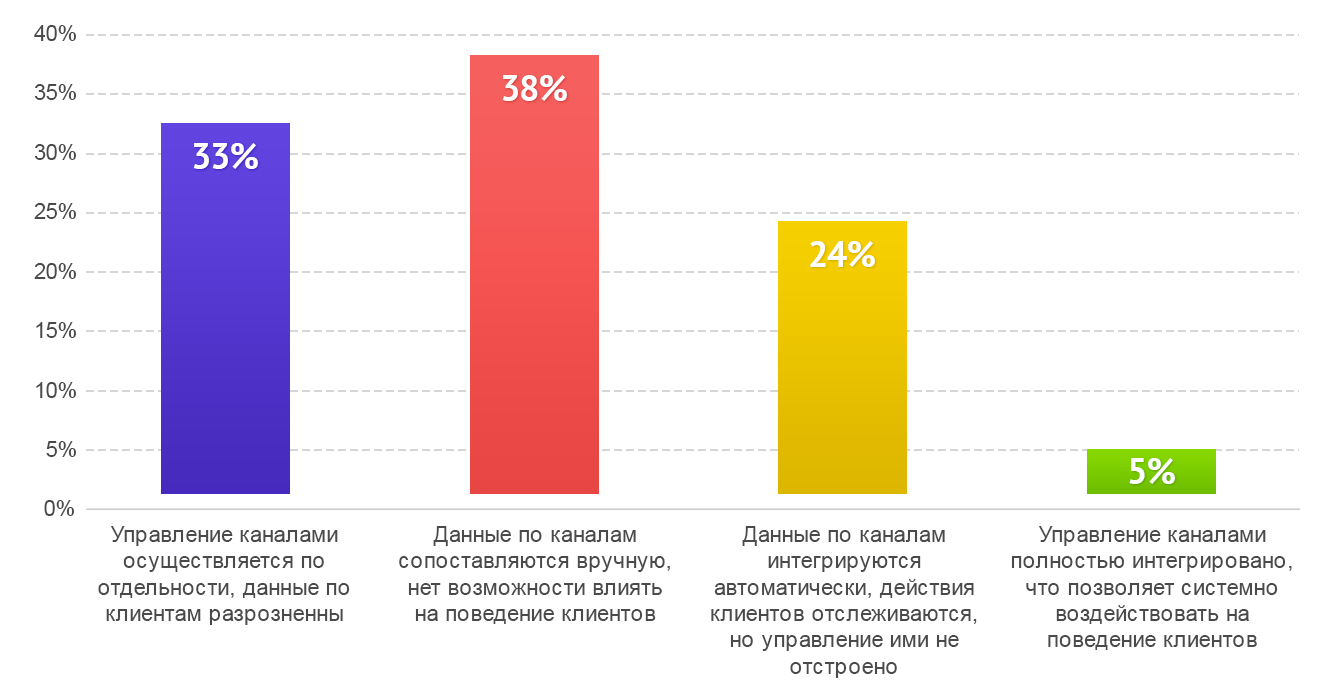Omni-channel - how is it in Russian?
“Omni-channel is an approach to trading, which implies the simultaneous use of all physical (offline) and digital (online) communication channels and implies an innovative opportunity to fully track the client's path. “Omni” comes from the Latin “omnibus” (“for all”), and channels in this case are understood to mean all the ways consumers interact with the brand. ” © Wikipedia

Every minute on the Earth 360 lightning strikes and at least one idea is born in the marketer's head. The most survivable of them acquire names that are scattered by catchy words throughout the ball. So the language of marketing is not a language at all, but a real professional pidgin , which is actively expanding in the lexicon of the most diverse national origin.
The Russian marketing community on it, of course, also thinks, speaks and works. And he immediately grasps what is behind the new words "flown in" and what practical benefits can be drawn from this. Well, almost always. There are times when things are not going so smoothly. This is when marketers are morally not ready to accept new tools and solutions.
Just about two years ago, the case with the approach that came to us from the European West under the name omni-channel turned out to be so. It was then that he was perceived by the most advanced part of the marketing community, having interpreted it in translation into Russian as “end-to-end analytics”. At the same time, by the way, CoMagic appeared - as the first domestic tool of end-to-end business intelligence, able to independently collect and link statistics on all company communication channels with customers. Since then, having joined forces with partner advertising agencies, the service has been trying to systematically convey the value of end-to-end analytics to the end consumer-marketer.
However, new ideas do not take root quickly. Therefore, only now, a couple of years and a couple of global conferences of Google and Yandex later, the trend of end-to-end analytics has begun to be realized truly deeply. And we are warmly glad that an increasing number of marketers are ready to take it on board.
')
However, one should not think that only here in Russia we are “slowing down”. Trend analytics is young and fresh for the rest of the world. Here, for example, is the curious data from a study conducted in early 2015 by Econsultancy.com . The guys started an online survey and, among other things, asked about 2000 English marketers from e-commerce and advertising agencies: “How strongly are your company connected to a single customer management system with a brand within various communication channels?” what they learned:

Just think: only 5% of companies in the UK have begun to practice end-to-end analytics. And these data can be quite legitimately extrapolated to all European countries. This, on the one hand, means that the market niche for this kind of toolkit is very extensive, and on the other hand, it says that you still need to make a lot of effort to bring its value to the final marketer.
What is this omni-channel after all? Now let's say loud, but nonetheless. As we see it, behind this is a change in marketing thinking in general. We turn to the model of the world revolving around the client, and not the channels of communication with him. Hence, a direct consequence is the realization that customers do not interact with the company within a separate channel, but use the most diverse of them on their “path”.
Accordingly, it is necessary to collect statistics on customer behavior across all channels of their calls, combining the data into a single report (in fact, it is this meaning that reflected the term “end-to-end analytics” that we got from). Only then it is possible to put forward working hypotheses and with maximum accuracy to understand where and how it is necessary to influence a potential client in order to bring it to the goal we need - say, a purchase or a call. So, consciously, systematically and effectively increase conversion.
In fact, win-win in its purest form. You coordinate with each other all communications with customers and achieve a guaranteed synergistic effect. For example, a site visitor who has spent a considerable amount of time on it or “dumped” the basket, send a push-notification with a reminder of the viewed product when opening the company's mobile application a few days later. Unless, of course, the accumulated statistics approve :)
And that's what's happening. Real-time end-to-end analytics track absolutely all customer actions and encourage you (as a marketer) to take a closer look at the interconnection of various communication channels. Regardless of how mature or prioritized they are in your eyes. You begin to look at what is happening through the eyes of a client. The picture of the world is clarified and corrected. And you are getting closer to the truth that, from the point of view of the end user, both e-commerce and retail are in essence the same thing now: just shopping. The last thought, by the way, was made by John Donahue (CEO of eBay).
In order for the indifferent theory to acquire warmth, we finally decided to ask Russian expert marketing experts about end-to-end analytics. How do they see it today in Russia? What does she have for them? And in general, are Russian companies ready, in their opinion, to implement this approach in practice?
Konstantin Bayandin, head of digital-marketing at Ozon.ru :

“We are already working with end-to-end analytics on a regular basis. This is important to do, in the first place, to understand the value of customers throughout the entire life cycle, as well as to calculate the return on investment in marketing and in the improvement of the website and logistics.
End-to-end analytics for Ozon.ru is an analysis of buyers' actions from the moment of their initial engagement to joining the site within the audience segments, as well as during the selection of purchases and their completion. In addition, this study of the conversion to paid orders during delivery and analysis of return to new purchases in the framework of long-term cohorts. The organization of end-to-end analytics is a rather lengthy and painstaking work on data bundling in different systems. It requires the integration of online advertising, web analytics, transactional systems and business analysis systems. We do not have full integration in all four stages at once, but we have the opportunity to conveniently analyze the behavior of customers in pairs and triples of these stages. We make a complete bundle of four stages for an individual analysis by ad hoc queries into the systems and “gluing together” data. ”
Vsevolod Baev, CEO of Media108 marketing agency :

“End-to-end analytics are data that can describe the maximum number of processes in a company in real time so that it can influence them. In the field of marketing, it is especially important to have a perfect analytics system in order to track the effect of marketing and promotional activities produced, as well as the market response to external factors.
Now we, like most of our partners, use the analogue of “end-to-end” analytics, but we have to collect data manually from various sources. Of course, this is additional labor and lost time. Therefore, we in Media108 are now engaged in the development of a product that allows us to see the entire slice of analytical data on advertising campaigns. ”
Egor Kozhevnikov, head of the contextual advertising department of Ashmanov & Partners :

“End-to-end analytics is tracking the funnel from the primary engagement of the user to the paid order. That is, it is analytics for users, not visits, where the final result is not just a completed form on the site or a call, but the fact of ordering a product or service. And through this funnel pass absolutely all channels and tools with which the user interacted. In fact, the client's “life cycle” continues in CRM: from awareness of need to the act of payment, and even after it. End-to-end analytics is something like nerve fibers that permeate the entire ecosystem of your business, connecting the most distant sites with each other and knowing exactly where it hurts. Marketers seem to have already experienced and laid down in consciousness the fact of the existence of associated conversions and the need to take them into account. Now a new round is the same end-to-end analytics that allows analyzing not only Internet data, but also linking it with data from offline (and thus understand the time to make a purchase decision or customer lifetime value (LTV).
We want to work with it! The problem is that many are afraid to let the agency inside their CRM, so that they "dig something in our sales." It's a pity, because the project promotion is a full-fledged bilateral work, and without allowing the agency to dive further than Analytics, customers lose significant budgets on this, because decisions are made not on the basis of real data, but on the assumption that "can work this season." We are now working in the near direction, but we are moving a little in the other direction. ”
Pavel Ryskov, Executive Director of the World of Advertising digital agency:

“End-to-end business analytics, in our understanding, is an analytical service that fully satisfies the client’s needs in increasing the profitability of a business from using advertising and slightly surpasses them so that you can keep the client in a state of slight amazement. Of course, this, at the same time, should ensure the maximum effect of the work of the agency in attracting customers to the customer. Some customers are not ready to immediately talk about the cost of sales (CPS) and ROI. Someone wants to work for the sale, but is not ready to share data from their system. Therefore, for each client, “end-to-end business analytics” is an individually customized product. In our opinion, it depends, on the one hand, on the agency’s ability to fully track the entire sales funnel, offering effective solutions for its expansion, and on the other hand, on the ability to understand the specifics of the customer’s business processes, by proposing a product based on its specificity. ”
Yuri Rybakov, head of the web analytics department at the iConText Performance Marketing Agency:

“A definite request for omni-channel analytics has been on the market for a long time, but with the update of Google Analytics to Universal Analytics, this approach has gained popularity and its demand is only growing. No wonder, because this tool was sharpened precisely by mixing data from different sources, and it is Google that is actively promoting this kind of analytics.
In the daily practice of an advertising agency, this means that for many clients we are now compiling data on interactions with the site, data from CRM, from call tracking systems and sometimes from applications — this is necessary for us to better analyze our advertising campaigns. In some cases, we also try to link this data with display advertising. This, of course, is not a complete omni-channel, but this is something that is simple enough, not too expensive and at the same time gives a good result for the client. That is the real money gain and placement efficiency. From interesting single experiences: it was necessary to help with setup of specially created systems for collecting such data, avoiding technical limitations of the Google product. There was also an interesting work with a telecom operator, which really knows a lot about its users. Now we can better analyze and relate the results of TV activities to other data. In general, business is still unable to fully integrate and analyze data on all of its interactions online and offline with each person. We do not know exactly, for example, who sees our billboard. But if a certain person turns to an advertiser company (calls, leaves a request, etc.), then this data can and should be brought together: where did he call from, were there any other contacts with him and where, what did he do before. This allows for a better analysis of not only advertising activity, but also other issues of business efficiency. ”
Sergey Pankov, CEO of Ingate Digital Agency :

“The end-to-end analytics approach is one of the most effective approaches in web analytics. When conducting advertising campaigns, we analyze all possible channels of client communications. This is done taking into account offline activity and using tools that are offered by Google Analytics and CoMagic. Such an approach allows us, in a complex and with the highest possible accuracy, to determine the effectiveness of each advertising campaign and ensure the maximum financial return from the Internet advertising of each of our clients. ”
Vadim Buyanov, director of development for Webtrend :

“The path of the Webtrend team to understanding the importance of working with end-to-end analytics has taken more than one year. Each new website we launched naturally needed promotion: whether it was contextual advertising, SEO promotion, or work with social networks. Advertising campaigns launched by us, as a rule, had formal evaluations: positions in TOP-10, cost per click and CTR, number of subscribers in a group, etc.
The mentioned metrics did not give an answer to the main questions: do the ongoing advertising campaigns really generate profit for the customer? Which advertising campaigns are the most profitable, and which ones only burn advertising budgets? And much more. The difficulty was added by the fact that most of the ongoing advertising campaigns were converted by means of telephone calls, which also had to be tracked both at the level of the source of the message and the keyword. For a while, we managed with classic analytics tools, such as Google Analytics / Yandex Metrika + Yandex Target Call, but this approach did not give 100% accuracy of data for making weighted management decisions: control of the marketing department, operator quality, efficiency of advertising budgets and representation of a complete sales funnel on the basis of a single CRM with the calculation of the corresponding KPI.
Combining all parts of the management mosaic together, and on the basis of a single platform, allowed us the decision of CoMagic, which already has integration with third-party web analytics and lead management, while itself being a very powerful analytical tool. Obviously, end-to-end analytics at the level of each campaign and a key request in conjunction with a customized CRM-based sales funnel is a new trend that will allow an internet marketing company to be ahead of the competition. ”
Artem Kazakov, Retail Rocket Marketing Director:

“The concept of“ end-to-end analytics ”implies the analysis of consumer interaction through (“ through ”) all communication channels. There is no consensus among the community today regarding the choice of a particular model of attribution of channels provided by modern web analytics systems. The only recognized axiom in the industry - for each task it is necessary to use its own individual attribution model.
Omni-channel for us is not just a fashionable business philosophy, which is to ensure the seamless integration of trade through all available sales channels (online / offline). In Retail Rocket, through the integration of our technologies in e-commerce, we demonstrate in practice that the consumer really does not feel any difference in the channels, purchasing goods in the way he is comfortable with at the moment. So, for example, together with the “Korablik” chain of children's goods stores, we were able to build the country's first case for generating e-commerce sales through personal product recommendations based on purchases in offline retail. In the project, we put together several complex information systems (CRM, ERP, ESP and personalization platform) and the results are available on the Retail Rocket blog. ”
Ilya Sidorov, performance sales activation specialist, Google Russia :

“Of all the sales affected by the online channel, no more than 30% occur on the Internet. The rest is shopping in stores or offices, phone calls or online sales, but from other devices. Most businesses still consider only the result obtained on the Internet, on the same device, in the same browser. This greatly limits the ability to correctly assess the effectiveness of marketing and to further optimize advertising. In 2013, we launched Universal Analytics, which allows us to track sales to one user on different devices and offline - by phone or in stores. The technology is free and available even for small companies, but requires customization and integration with CRM. There are not enough specialists who could do this. This leads to the fact that despite the availability of tools, cases of complete integration of end-to-end analytics are still isolated and are the exception rather than the rule.
Nevertheless, given the fact that end-to-end analytics allows you to increase the effectiveness of investment in advertising and more correctly optimize it, more and more companies are embarking on the introduction of such analytics. After a year or two, a successful business without end-to-end analytics will be as difficult to imagine as a successful company without standard online analytics today. ”
Dmitry Kudinov, CEO and founder of CoMagic :

“Omni-channel for us is the basis of the ideology of the service, it can be said, the meaning of our life :)
As pioneers of “end-to-end analytics” in Russia, we at CoMagic today have the most functional technology platform that allows you to automatically combine all types of conversions and downloads from site visitors, regardless of the communication channel (online orders, phone calls). chats in an online consultant, applications, leads or letters).
We are very pleased to provide our customers and partners with technology and tools that allow you to increase the effectiveness of advertising and the quality of their interaction with customers. We definitely see in the omni-channel the future of Internet marketing, while not only “seeing”, but also embodying it ourselves. ”
And then, attention, question! And what do you understand by end-to-end analytics? Are you ready to work with it as a tool? And if you are already working, share your experience - we are really interested, we want to know :)

Every minute on the Earth 360 lightning strikes and at least one idea is born in the marketer's head. The most survivable of them acquire names that are scattered by catchy words throughout the ball. So the language of marketing is not a language at all, but a real professional pidgin , which is actively expanding in the lexicon of the most diverse national origin.
The Russian marketing community on it, of course, also thinks, speaks and works. And he immediately grasps what is behind the new words "flown in" and what practical benefits can be drawn from this. Well, almost always. There are times when things are not going so smoothly. This is when marketers are morally not ready to accept new tools and solutions.
Just about two years ago, the case with the approach that came to us from the European West under the name omni-channel turned out to be so. It was then that he was perceived by the most advanced part of the marketing community, having interpreted it in translation into Russian as “end-to-end analytics”. At the same time, by the way, CoMagic appeared - as the first domestic tool of end-to-end business intelligence, able to independently collect and link statistics on all company communication channels with customers. Since then, having joined forces with partner advertising agencies, the service has been trying to systematically convey the value of end-to-end analytics to the end consumer-marketer.
However, new ideas do not take root quickly. Therefore, only now, a couple of years and a couple of global conferences of Google and Yandex later, the trend of end-to-end analytics has begun to be realized truly deeply. And we are warmly glad that an increasing number of marketers are ready to take it on board.
')
However, one should not think that only here in Russia we are “slowing down”. Trend analytics is young and fresh for the rest of the world. Here, for example, is the curious data from a study conducted in early 2015 by Econsultancy.com . The guys started an online survey and, among other things, asked about 2000 English marketers from e-commerce and advertising agencies: “How strongly are your company connected to a single customer management system with a brand within various communication channels?” what they learned:

Just think: only 5% of companies in the UK have begun to practice end-to-end analytics. And these data can be quite legitimately extrapolated to all European countries. This, on the one hand, means that the market niche for this kind of toolkit is very extensive, and on the other hand, it says that you still need to make a lot of effort to bring its value to the final marketer.
Insight end-to-end analytics: think like a customer
What is this omni-channel after all? Now let's say loud, but nonetheless. As we see it, behind this is a change in marketing thinking in general. We turn to the model of the world revolving around the client, and not the channels of communication with him. Hence, a direct consequence is the realization that customers do not interact with the company within a separate channel, but use the most diverse of them on their “path”.
Accordingly, it is necessary to collect statistics on customer behavior across all channels of their calls, combining the data into a single report (in fact, it is this meaning that reflected the term “end-to-end analytics” that we got from). Only then it is possible to put forward working hypotheses and with maximum accuracy to understand where and how it is necessary to influence a potential client in order to bring it to the goal we need - say, a purchase or a call. So, consciously, systematically and effectively increase conversion.
In fact, win-win in its purest form. You coordinate with each other all communications with customers and achieve a guaranteed synergistic effect. For example, a site visitor who has spent a considerable amount of time on it or “dumped” the basket, send a push-notification with a reminder of the viewed product when opening the company's mobile application a few days later. Unless, of course, the accumulated statistics approve :)
And that's what's happening. Real-time end-to-end analytics track absolutely all customer actions and encourage you (as a marketer) to take a closer look at the interconnection of various communication channels. Regardless of how mature or prioritized they are in your eyes. You begin to look at what is happening through the eyes of a client. The picture of the world is clarified and corrected. And you are getting closer to the truth that, from the point of view of the end user, both e-commerce and retail are in essence the same thing now: just shopping. The last thought, by the way, was made by John Donahue (CEO of eBay).
How do experts see this
In order for the indifferent theory to acquire warmth, we finally decided to ask Russian expert marketing experts about end-to-end analytics. How do they see it today in Russia? What does she have for them? And in general, are Russian companies ready, in their opinion, to implement this approach in practice?
Konstantin Bayandin, head of digital-marketing at Ozon.ru :

“We are already working with end-to-end analytics on a regular basis. This is important to do, in the first place, to understand the value of customers throughout the entire life cycle, as well as to calculate the return on investment in marketing and in the improvement of the website and logistics.
End-to-end analytics for Ozon.ru is an analysis of buyers' actions from the moment of their initial engagement to joining the site within the audience segments, as well as during the selection of purchases and their completion. In addition, this study of the conversion to paid orders during delivery and analysis of return to new purchases in the framework of long-term cohorts. The organization of end-to-end analytics is a rather lengthy and painstaking work on data bundling in different systems. It requires the integration of online advertising, web analytics, transactional systems and business analysis systems. We do not have full integration in all four stages at once, but we have the opportunity to conveniently analyze the behavior of customers in pairs and triples of these stages. We make a complete bundle of four stages for an individual analysis by ad hoc queries into the systems and “gluing together” data. ”
Vsevolod Baev, CEO of Media108 marketing agency :

“End-to-end analytics are data that can describe the maximum number of processes in a company in real time so that it can influence them. In the field of marketing, it is especially important to have a perfect analytics system in order to track the effect of marketing and promotional activities produced, as well as the market response to external factors.
Now we, like most of our partners, use the analogue of “end-to-end” analytics, but we have to collect data manually from various sources. Of course, this is additional labor and lost time. Therefore, we in Media108 are now engaged in the development of a product that allows us to see the entire slice of analytical data on advertising campaigns. ”
Egor Kozhevnikov, head of the contextual advertising department of Ashmanov & Partners :

“End-to-end analytics is tracking the funnel from the primary engagement of the user to the paid order. That is, it is analytics for users, not visits, where the final result is not just a completed form on the site or a call, but the fact of ordering a product or service. And through this funnel pass absolutely all channels and tools with which the user interacted. In fact, the client's “life cycle” continues in CRM: from awareness of need to the act of payment, and even after it. End-to-end analytics is something like nerve fibers that permeate the entire ecosystem of your business, connecting the most distant sites with each other and knowing exactly where it hurts. Marketers seem to have already experienced and laid down in consciousness the fact of the existence of associated conversions and the need to take them into account. Now a new round is the same end-to-end analytics that allows analyzing not only Internet data, but also linking it with data from offline (and thus understand the time to make a purchase decision or customer lifetime value (LTV).
We want to work with it! The problem is that many are afraid to let the agency inside their CRM, so that they "dig something in our sales." It's a pity, because the project promotion is a full-fledged bilateral work, and without allowing the agency to dive further than Analytics, customers lose significant budgets on this, because decisions are made not on the basis of real data, but on the assumption that "can work this season." We are now working in the near direction, but we are moving a little in the other direction. ”
Pavel Ryskov, Executive Director of the World of Advertising digital agency:

“End-to-end business analytics, in our understanding, is an analytical service that fully satisfies the client’s needs in increasing the profitability of a business from using advertising and slightly surpasses them so that you can keep the client in a state of slight amazement. Of course, this, at the same time, should ensure the maximum effect of the work of the agency in attracting customers to the customer. Some customers are not ready to immediately talk about the cost of sales (CPS) and ROI. Someone wants to work for the sale, but is not ready to share data from their system. Therefore, for each client, “end-to-end business analytics” is an individually customized product. In our opinion, it depends, on the one hand, on the agency’s ability to fully track the entire sales funnel, offering effective solutions for its expansion, and on the other hand, on the ability to understand the specifics of the customer’s business processes, by proposing a product based on its specificity. ”
Yuri Rybakov, head of the web analytics department at the iConText Performance Marketing Agency:

“A definite request for omni-channel analytics has been on the market for a long time, but with the update of Google Analytics to Universal Analytics, this approach has gained popularity and its demand is only growing. No wonder, because this tool was sharpened precisely by mixing data from different sources, and it is Google that is actively promoting this kind of analytics.
In the daily practice of an advertising agency, this means that for many clients we are now compiling data on interactions with the site, data from CRM, from call tracking systems and sometimes from applications — this is necessary for us to better analyze our advertising campaigns. In some cases, we also try to link this data with display advertising. This, of course, is not a complete omni-channel, but this is something that is simple enough, not too expensive and at the same time gives a good result for the client. That is the real money gain and placement efficiency. From interesting single experiences: it was necessary to help with setup of specially created systems for collecting such data, avoiding technical limitations of the Google product. There was also an interesting work with a telecom operator, which really knows a lot about its users. Now we can better analyze and relate the results of TV activities to other data. In general, business is still unable to fully integrate and analyze data on all of its interactions online and offline with each person. We do not know exactly, for example, who sees our billboard. But if a certain person turns to an advertiser company (calls, leaves a request, etc.), then this data can and should be brought together: where did he call from, were there any other contacts with him and where, what did he do before. This allows for a better analysis of not only advertising activity, but also other issues of business efficiency. ”
Sergey Pankov, CEO of Ingate Digital Agency :

“The end-to-end analytics approach is one of the most effective approaches in web analytics. When conducting advertising campaigns, we analyze all possible channels of client communications. This is done taking into account offline activity and using tools that are offered by Google Analytics and CoMagic. Such an approach allows us, in a complex and with the highest possible accuracy, to determine the effectiveness of each advertising campaign and ensure the maximum financial return from the Internet advertising of each of our clients. ”
Vadim Buyanov, director of development for Webtrend :

“The path of the Webtrend team to understanding the importance of working with end-to-end analytics has taken more than one year. Each new website we launched naturally needed promotion: whether it was contextual advertising, SEO promotion, or work with social networks. Advertising campaigns launched by us, as a rule, had formal evaluations: positions in TOP-10, cost per click and CTR, number of subscribers in a group, etc.
The mentioned metrics did not give an answer to the main questions: do the ongoing advertising campaigns really generate profit for the customer? Which advertising campaigns are the most profitable, and which ones only burn advertising budgets? And much more. The difficulty was added by the fact that most of the ongoing advertising campaigns were converted by means of telephone calls, which also had to be tracked both at the level of the source of the message and the keyword. For a while, we managed with classic analytics tools, such as Google Analytics / Yandex Metrika + Yandex Target Call, but this approach did not give 100% accuracy of data for making weighted management decisions: control of the marketing department, operator quality, efficiency of advertising budgets and representation of a complete sales funnel on the basis of a single CRM with the calculation of the corresponding KPI.
Combining all parts of the management mosaic together, and on the basis of a single platform, allowed us the decision of CoMagic, which already has integration with third-party web analytics and lead management, while itself being a very powerful analytical tool. Obviously, end-to-end analytics at the level of each campaign and a key request in conjunction with a customized CRM-based sales funnel is a new trend that will allow an internet marketing company to be ahead of the competition. ”
Artem Kazakov, Retail Rocket Marketing Director:

“The concept of“ end-to-end analytics ”implies the analysis of consumer interaction through (“ through ”) all communication channels. There is no consensus among the community today regarding the choice of a particular model of attribution of channels provided by modern web analytics systems. The only recognized axiom in the industry - for each task it is necessary to use its own individual attribution model.
Omni-channel for us is not just a fashionable business philosophy, which is to ensure the seamless integration of trade through all available sales channels (online / offline). In Retail Rocket, through the integration of our technologies in e-commerce, we demonstrate in practice that the consumer really does not feel any difference in the channels, purchasing goods in the way he is comfortable with at the moment. So, for example, together with the “Korablik” chain of children's goods stores, we were able to build the country's first case for generating e-commerce sales through personal product recommendations based on purchases in offline retail. In the project, we put together several complex information systems (CRM, ERP, ESP and personalization platform) and the results are available on the Retail Rocket blog. ”
Ilya Sidorov, performance sales activation specialist, Google Russia :

“Of all the sales affected by the online channel, no more than 30% occur on the Internet. The rest is shopping in stores or offices, phone calls or online sales, but from other devices. Most businesses still consider only the result obtained on the Internet, on the same device, in the same browser. This greatly limits the ability to correctly assess the effectiveness of marketing and to further optimize advertising. In 2013, we launched Universal Analytics, which allows us to track sales to one user on different devices and offline - by phone or in stores. The technology is free and available even for small companies, but requires customization and integration with CRM. There are not enough specialists who could do this. This leads to the fact that despite the availability of tools, cases of complete integration of end-to-end analytics are still isolated and are the exception rather than the rule.
Nevertheless, given the fact that end-to-end analytics allows you to increase the effectiveness of investment in advertising and more correctly optimize it, more and more companies are embarking on the introduction of such analytics. After a year or two, a successful business without end-to-end analytics will be as difficult to imagine as a successful company without standard online analytics today. ”
Dmitry Kudinov, CEO and founder of CoMagic :

“Omni-channel for us is the basis of the ideology of the service, it can be said, the meaning of our life :)
As pioneers of “end-to-end analytics” in Russia, we at CoMagic today have the most functional technology platform that allows you to automatically combine all types of conversions and downloads from site visitors, regardless of the communication channel (online orders, phone calls). chats in an online consultant, applications, leads or letters).
We are very pleased to provide our customers and partners with technology and tools that allow you to increase the effectiveness of advertising and the quality of their interaction with customers. We definitely see in the omni-channel the future of Internet marketing, while not only “seeing”, but also embodying it ourselves. ”
How do you see it?
And then, attention, question! And what do you understand by end-to-end analytics? Are you ready to work with it as a tool? And if you are already working, share your experience - we are really interested, we want to know :)
Source: https://habr.com/ru/post/293176/
All Articles